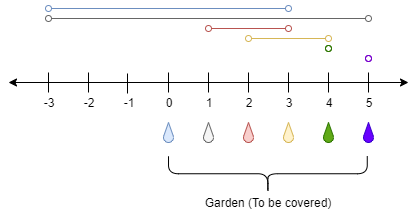原文链接: https://leetcode-cn.com/problems/minimum-number-of-taps-to-open-to-water-a-garden
英文原文
There is a one-dimensional garden on the x-axis. The garden starts at the point 0 and ends at the point n. (i.e The length of the garden is n).
There are n + 1 taps located at points [0, 1, ..., n] in the garden.
Given an integer n and an integer array ranges of length n + 1 where ranges[i] (0-indexed) means the i-th tap can water the area [i - ranges[i], i + ranges[i]] if it was open.
Return the minimum number of taps that should be open to water the whole garden, If the garden cannot be watered return -1.
Example 1:

Input: n = 5, ranges = [3,4,1,1,0,0] Output: 1 Explanation: The tap at point 0 can cover the interval [-3,3] The tap at point 1 can cover the interval [-3,5] The tap at point 2 can cover the interval [1,3] The tap at point 3 can cover the interval [2,4] The tap at point 4 can cover the interval [4,4] The tap at point 5 can cover the interval [5,5] Opening Only the second tap will water the whole garden [0,5]
Example 2:
Input: n = 3, ranges = [0,0,0,0] Output: -1 Explanation: Even if you activate all the four taps you cannot water the whole garden.
Example 3:
Input: n = 7, ranges = [1,2,1,0,2,1,0,1] Output: 3
Example 4:
Input: n = 8, ranges = [4,0,0,0,0,0,0,0,4] Output: 2
Example 5:
Input: n = 8, ranges = [4,0,0,0,4,0,0,0,4] Output: 1
Constraints:
1 <= n <= 104ranges.length == n + 10 <= ranges[i] <= 100
中文题目
在 x 轴上有一个一维的花园。花园长度为 n,从点 0 开始,到点 n 结束。
花园里总共有 n + 1 个水龙头,分别位于 [0, 1, ..., n] 。
给你一个整数 n 和一个长度为 n + 1 的整数数组 ranges ,其中 ranges[i] (下标从 0 开始)表示:如果打开点 i 处的水龙头,可以灌溉的区域为 [i - ranges[i], i + ranges[i]] 。
请你返回可以灌溉整个花园的 最少水龙头数目 。如果花园始终存在无法灌溉到的地方,请你返回 -1 。
示例 1:

输入:n = 5, ranges = [3,4,1,1,0,0] 输出:1 解释: 点 0 处的水龙头可以灌溉区间 [-3,3] 点 1 处的水龙头可以灌溉区间 [-3,5] 点 2 处的水龙头可以灌溉区间 [1,3] 点 3 处的水龙头可以灌溉区间 [2,4] 点 4 处的水龙头可以灌溉区间 [4,4] 点 5 处的水龙头可以灌溉区间 [5,5] 只需要打开点 1 处的水龙头即可灌溉整个花园 [0,5] 。
示例 2:
输入:n = 3, ranges = [0,0,0,0] 输出:-1 解释:即使打开所有水龙头,你也无法灌溉整个花园。
示例 3:
输入:n = 7, ranges = [1,2,1,0,2,1,0,1] 输出:3
示例 4:
输入:n = 8, ranges = [4,0,0,0,0,0,0,0,4] 输出:2
示例 5:
输入:n = 8, ranges = [4,0,0,0,4,0,0,0,4] 输出:1
提示:
1 <= n <= 10^4ranges.length == n + 10 <= ranges[i] <= 100
通过代码
高赞题解

解题思路:
n代表土地数量(0 - 1 之间是一块地,1 - 2 之间是一块地)n + 1代表水龙头数量,水龙头插在数字上ranges代表当前位置的水龙头,向左向右可以覆盖多少块地- 定义一个
land数据- 代表在所有能够覆盖这块土地的所有水龙头中,找到能够覆盖最远(右边)位置的水龙头,记录它最右覆盖的土地
- 比如图例中,索引 0 代表覆盖了 0 - 1 之间这块地的所有水龙头里能够覆盖到最右的土地
- 值是 5 ,代表覆盖到最右边的是 4 - 5 这块土地
索引是水龙头右边的那块地,而值是水龙头左边的那块地
因此下面代码中 cur = land[cur]; 表示无缝的覆盖过去
- 将
ranges转换为land数据- 遍历
ranges,解析其范围,将范围内的land更新为最大值
- 遍历
- 从土地 0 开始,一直到土地 n ,记录水龙头数目
代码:
[]int minTaps(int n, vector<int>& ranges) { vector<int> land(n); for (int i = 0; i < ranges.size(); i++) { int l = max(i - ranges[i], 0); int r = min(i + ranges[i], n); for (int j = l; j < r; j++) { land[j] = max(land[j], r); } } int cnt = 0; int cur = 0; while (cur < n) { if (land[cur] == 0) return -1; cur = land[cur]; cnt++; } return cnt; }
致谢
感谢您的观看,希望对您有帮助,欢迎热烈的交流!
统计信息
| 通过次数 | 提交次数 | AC比率 |
|---|---|---|
| 5985 | 12668 | 47.2% |
提交历史
| 提交时间 | 提交结果 | 执行时间 | 内存消耗 | 语言 |
|---|




